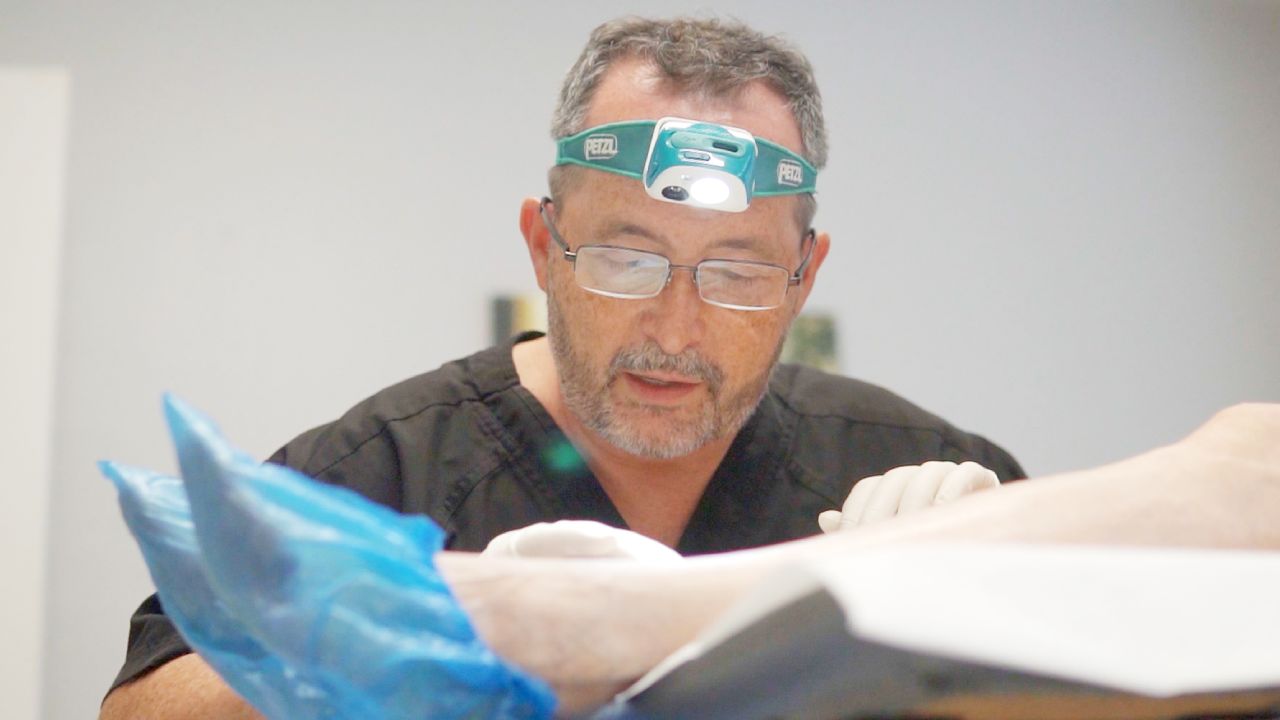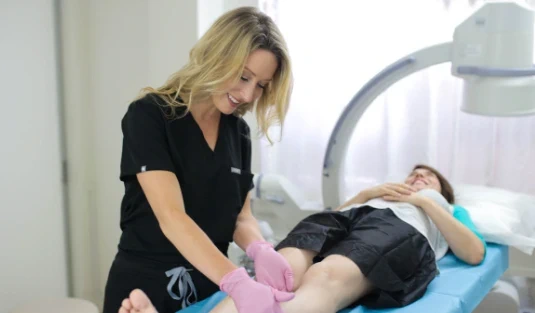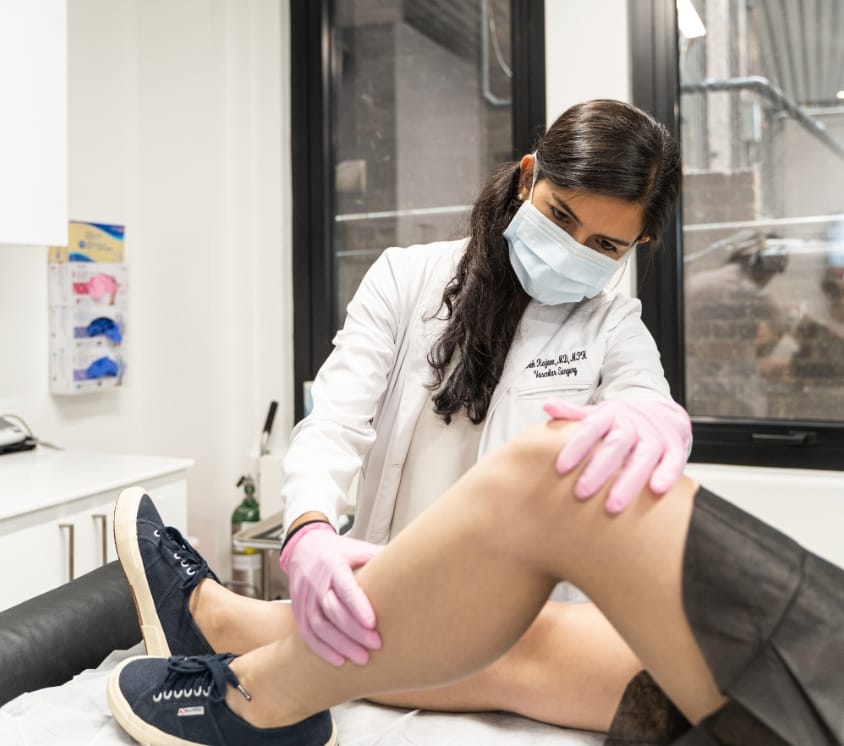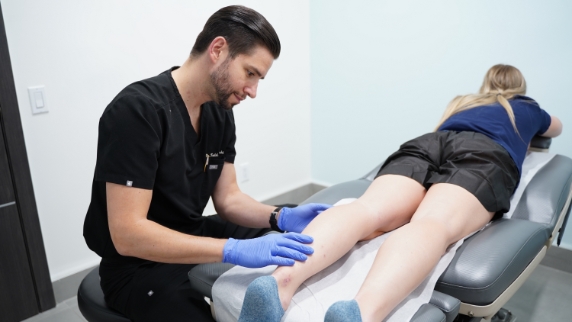EVLT is a minimally invasive, very effective procedure to eliminate varicose veins. It uses laser energy from laser light to make the vein collapse quickly. The treated vein will eventually disappear. Endovascular laser treatment is a quick procedure and patients are encouraged to resume their normal activities in a few days. Since the vein doctor will numb the area with a local anesthetic, you will not feel any pain during the procedure.
For decades, the only treatment for unsightly and uncomfortable varicose veins was an invasive surgery known as vein stripping. Fortunately, options for managing vein disease have advanced significantly in recent years. One of the most effective is laser treatment for varicose veins. This procedure relies on a highly focused light beam to close unhealthy vessels. It is minimally invasive, and you can return to your normal routine within a day or two.
Laser treatment for varicose veins can be done at your local Vein Treatment Clinic. There is no need for hospitalization, and depending on the number of vessels being treated, the procedure can be completed in under an hour. Ask your vein doctor during your next visit if this procedure is correct.
Before discussing the details of endovenous laser treatment for varicose veins, let’s give a quick overview of varicose veins and their entails.
What Causes Varicose Veins?
Many patients with varicose veins believe they are simply a cosmetic issue. Unfortunately, that is not always the case. Varicose veins and spider veins can be signs of more serious underlying vein disease.
Your arteries carry oxygenated blood from your lungs to the rest of your body. Once all of the oxygen has been delivered, veins move the blood back to your heart, which pushes it to the lungs for a new oxygen supply. These hard-working vessels have to work against gravity when transporting blood from your feet and legs, so a system of tiny one-way valves is in place to ensure no backflow.
When the valves in your veins become diseased or damaged, blood can leak through. It pools in the lower half of your body, increasing pressure on the vein walls. Veins become swollen and twisted and begin to protrude against your skin. This is what you are seeing when you notice varicose veins. The saphenous vein, which carries blood from your feet to the top of your thighs, is at particular risk for this issue. It is very close to the surface of your skin.
Spider veins have the exact underlying cause, but they look slightly different. Instead of the thick, swollen, bulges of varicose veins, you will notice networks of thin purple, blue, and red lines just beneath the surface of your skin.
As extra blood collects in the lower half of your body, the increased pressure damages more of your valves. This progressive condition is referred to as Chronic Venous Insufficiency (CVI). Unfortunately, CVI is underdiagnosed, and many patients don’t receive the treatment they need to manage the disease. Your vein doctor in NY, NJ, MD, and CA specializes in identifying and correcting vein disease before your symptoms become more serious.
What are the Symptoms of Vein Disease?
Varicose veins and spider veins may be the most obvious signs of CVI, but there are a number of other symptoms that can cause you discomfort. Leg cramps are very common, especially at night, and you may notice aching, throbbing, weakness, or heaviness in your legs.
Swelling is of particular concern, because it can lead to a variety of additional issues. Skin on your legs and ankles starts to feel itchy, then it thickens and becomes discolored as the disease progresses. If left untreated, you can develop Venous Stasis Dermatitis, putting you at risk for cellulitis and other serious medical conditions.
Who is at Risk for Vein Disease?
Some of the risk factors for vein disease are outside your control. For example, you are at higher risk if you have a family history of varicose veins. You may also be at risk if you have had blood clots, an injury to your legs, or cancer. Varicose veins are an unfortunate reality for many pregnant women, and CVI is also more likely for women going through menopause.
Other risk factors are based on your lifestyle. Individuals who are overweight or obese have a greater likelihood of developing CVI, as do people who smoke. Spending a lot of time standing or sitting can also contribute to the problem, because inactivity increases the pressure in your veins.
How does laser treatment for varicose veins work?
Endovenous laser treatment for varicose veins uses laser energy to close unhealthy vessels. This procedure is typically referred to as Endоvеnоuѕ Laser Ablаtіоn (EVLA). It is minimally invasive and takes less than an hour of your time.
The first step is to numb the area being treated, so you don’t experience any pain during the procedure. Your physician uses a local anesthetic, so you don’t have to undergo general anesthesia. Relying on an ultrasound for guidance, a thin laser fiber is inserted into the unhealthy vessel. Then, laser energy is applied to permanently seal the vein. Your blood is automatically rerouted to other, healthier veins. Eventually, tissue from the treated vein is reabsorbed by your body, and all signs of the varicose veins and spider veins are gone.
How does endovenous laser treatment eliminate varicose veins?
The first step of the treatment is to fix the venous insufficiency, and the next step is to fix the varicose veins. It is just like a leaky pipe inside a wall. The leaky pipe is the great saphenous vein – veins that are slightly deeper within the leg. This great saphenous vein is prone to leaky valves and venous insufficiency. The varicose veins and spider veins are merely stains that are visible on the surface as a result of the leaky saphenous vein.
EVLT is one method (there are others, like RFA and Venaseal) that is used to seal the unhealthy saphenous veins and close them down. EVLT works by heating the saphenous veins from the inside, thus sealing the walls.
What are the pros and cons of EVLT?
Traditional surgery that involved removal of veins (or tying them closed). So, many excisions were required and the recovery took weeks. The distinct advantage of Endovenous laser treatment is that it uses laser energy to treat varicose veins and this needs just an incision. The vein doctor will numb the area around the treated vein with a local anesthetic, so there will be no pain during the actual procedure.
Pros of Laser Treatment
Here are some of the advantages;
- Mild discomfort
- Skin does not discolor
- No scars or marks
- Procedure time is 1 hour
- Return to normal routine immediately
Cons of Laser Treatment
There are a few disadvantages that must be mentioned;
- Needles will be used during EVLT
- More discomfort than with radiofrequency ablation.
- No swimming or heavy exercises for a week
What are the possible side-effects of laser treatment?
EVLT uses laser energy from a laser light and is considered a safe procedure that takes just about 60 – 90 minutes for each leg. A majority of the patients don’t experience any side effects. At Vein Treatment Clinic, we are very committed to taking steps to prevent any type of infection to patients. We maintain clean and sterile supplies and surfaces. But there are some side effects of EVLT that could occur.
Our specialist vein doctors encourage the patients who have had EVLT to report the following symptoms immediately:
- Burns caused due to extended exposure to laser light.
- Swelling and redness
- Nerve damage that may cause numbness or a tingling sensation.
- Change of skin color on the vein
- Excessive bleeding at the site of treatment
- Blood clots
- Itchy or painful veins
- Deep vein thrombosis is the most serious side effect of Endovenous laser treatment. Though it is rare, symptoms include swelling, pain, tenderness, and bluish coloration of leg muscles and calf muscles.
How Long Does Recovery from Laser Treatment for Varicose Veins Take?
Once the procedure is completed, you can resume walking and other basic daily activities right away! You should avoid strenuous exercise and long periods of sitting or standing until you have fully recovered. Your vein doctor will ask you to wear compression stockings for about a week to support healthy circulation, and you will return for a follow-up visit to confirm that the treated vein is fully closed.
Is endovenous laser treatment the only method to eliminate varicose veins?
No, Endovenous laser treatment is only one of the several methods used for treating varicose veins. The vein doctors at the Vein treatment clinic located near you will be able to explain the different technologies that are available for effective treatment of varicose veins. Our vein specialists prefer Radiofrequency ablation (RFA) to EVLT because it causes lesser perioperative discomfort.
The best treatment option for you can be decided by your local vein doctor. The treatment will ultimately depend on the individual patient – the condition of their veins, their needs, and lifestyle.
What are my other vein treatment options?
Laser treatment for varicose veins is a popular choice, because it is effective in 97 percent of cases. The risk of complications is quite low, and most patients do not experience pain or discomfort during the procedure. However, if this option isn’t quite right for you, your vein specialist may suggest an alternative. Other minimally invasive techniques for closing unhealthy veins include the following:
- Sclerotherapy – a medical injection
- Radiofrequency Ablаtіоn (RFA) – thermal energy
- VеnаSеаl – vein glue
- Clarivein – rotating wire
All of these can be done in your physician’s office, and they have all been proven effective and virtually pain-free. Your vein doctor will help you choose the best method for your needs.















